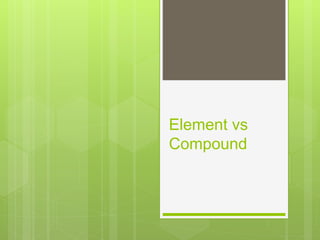
Elements vs. compounds
- 2. Learning Goals Define compounds. Identify and name some common compounds. Explain how compounds are formed. Compare element and compound. Classify substances as element or compound.
- 3. RECAP
- 4. What’s an element? Remember…. A pure substance….that can not be broken down into another substance….. Name 5 elements?
- 5. Discussion: Do you think elements combine? Explain your thinking…. provide evidence? Salt Water Sugar
- 6. Compound write this down in your notebook Pure substance composed of two or more different elements joined by chemical bonds. These chemical bonds can only be separated by other chemicals. You can not physically pull, cut, or tear a compound apart. Made of elements in a specific ratio .
- 7. Sodium is an extremely reactive metal that dulls almost instantly upon exposure to air.
- 8. Chlorine is a yellow gas with a pungent odor. It is highly reactive and poisonous.
- 9. The compound formed by sodium and chlorine is table salt. The properties of a compound are, in general, different from the properties of the elements that compose it.
- 10. The compound formed by sodium and chlorine is table salt. The properties of a compound are, in general, different from the properties of the elements that compose it.
- 11. A chemical formula indicates the elements present in a compound and the relative number of atoms of each. For example, H2O is the chemical formula for water; it indicates that water consists of hydrogen and oxygen atoms in a 2:1 ratio. The formula contains the symbol for each element, accompanied by a subscript indicating the number of atoms of that element. By convention, a subscript of 1 is omitted.
- 12. What are the element ratios for these common chemical formulas: NaCl CO2 C12H22O11
- 13. The subscripts in a chemical formula are part of the compound’s definition—if they change, the formula no longer specifies the same compound.
- 14. Chemical formulas list the most metallic elements first. The formula for table salt is NaCl, not ClNa. In compounds that do not include a metal, the more metal-like element is listed first.
- 15. Among nonmetals, those to the left in the periodic table are more metal-like than those to the right and are normally listed first. We write NO2 and NO, not O2N and ON. Within a single column in the periodic table, elements toward the bottom are more metal- like than elements toward the top. We write SO2, not O2S.
- 16. Among nonmetals, those to the left in the periodic table are more metal-like than those to the right and are normally listed first. We write NO2 and NO, not O2N and ON. Within a single column in the periodic table, elements toward the bottom are more metal- like than elements toward the top. We write SO2, not O2S.
- 18. What does ratio mean? How much of one thing is compared to another.
- 19. Compound CO is a deadly compound… What two elements is it made from? What is the ratio of elements? Carbon and Oxygen Waist gas from an engine. Carbon Monoxide
- 20. Carbon Monoxide
- 21. Compound NaCl/ is a common compound… What two elements is it made from? What is the ratio of elements? Sodium Chlorine/Chloride Salt
- 22. Sodium Chloride A square compound under a microscope.
- 23. Compound C12H22O11 is a common compound… What three elements is it made from? What is the ratio of elements? Carbon Hydrogen Oxygen Table sugar
- 24. Sugar
- 25. Compound SiO2is a common compound… What two elements is it made from? What is the ratio of elements? Silicon Oxygen Silicon Oxide Sand
- 26. 1 Silicon element Chemically bonded to 2 Oxygen elements
- 27. Compound N2O is a common compound… What two elements is it made from? What is the ratio of elements? Nitrogen Oxygen Nitrous Oxide Laughing Gas
- 29. Discussion: What’s the difference between an element and a compound? An element contains just one type of atom. A compound contains two or more different atoms joined chemically in a ratio.
- 30. Common examples of compound
- 33. Element, or Compound? Table Sugar
- 34. Element, or Compound? Table Sugar
- 37. Element or Compound,? Neon Gas
- 38. Element, or Compound? Neon Gas
- 39. Element, or Compound,? Pure Water
- 40. Element, or Compound? Pure Water
- 48. Compound Discovery It is the year 2032 and you and a partner have just been asked to join NASA on a trip to Jupiter. On this trip, your team discovered a brand new compound that no one has ever seen. Upon further investigation, you also noticed the compound was made up of elements commonly found on the periodic table and ones that have also never been seen. To introduce the world to the new compound, you need to chart the following information: Name of Compound Colored Picture of the discovered compound Description of the physical and chemical properties of the compound List of all of the elements that are bonded together to make up the compound (minimum of 2, real or made up) Atomic #, Atomic Mass, Protons, Neutrons and Electrons written out for each element Atomic Drawing of the compound. Showing how each element bonds to the other (Protons, Neutrons and Electrons) (Each Element wants 8 electrons in their outer roadway, so they may share electrons/Bond)